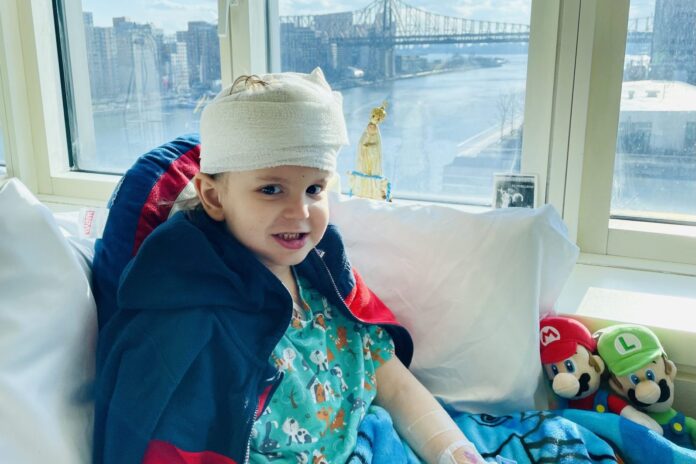As young Jonah fought embryonal tumor with multilayered rosettes (ETMR), a very rare and aggressive pediatric brain tumor, he returned to the operating room at Weill Cornell Medicine Brain & Spine Center again and again. But the tenacious tumor kept coming back — and pediatric neurosurgeon Jeffrey Greenfield, MD, PhD, recognized the opportunity that presented on the laboratory bench.
ETMR, which has a dismal 5-year survival rate of less than 30%, is so rare that even a high-volume center like Weill Cornell Medicine treats only a couple of cases a year. The condition wasn’t even defined until 2016.
“Very little is understood about the rarest of pediatric brain tumors because so few research labs have had access to study the tumor tissue,” explained Greenfield, a professor of neurological surgery at Weill Cornell Medicine who won a 2022 Hard-to-Treat Award from Children’s Cancer Research Fund (CCRF).
From bedside to bench – and back
It was that challenge that spurred Greenfield, who started his career as a laboratory scientist, to go to medical school in the first place. “I opened up a translational lab with the intent of being a neurosurgeon who could essentially use his operating room as an extension of his laboratory. There’s a real simplicity and beauty to both taking out the tumors and then immediately bringing them down the hall to your laboratory to study them,” he explained.
Greenfield, who co-founded the Children’s Brain Tumor Project at Weill Cornell Medicine, is especially intrigued by the hard-to-treat cancers that don’t get as much attention — including ETMR. Rare tumors are well suited for precision medicine, he said.
“The idea is can we glean something about a rare tumor that doesn’t have a standard of care, where kids don’t necessarily have a go-to algorithm or a center of excellence, where we can say, ‘We’re going study your tumor in a dish, in an animal and with drug screening’ — those are the three pillars of the precision medicine program,” he said. “And so ETMR emerged as a really fascinating disease for us because we had a child who had multiple recurrences of this disease, who continued to come for surgeries and resections, which allowed us a really unique glimpse into the longitudinal evolution of the tumor itself.”
A boy’s brain and his remarkable gift to science
By donating Jonah’s tumor tissue for research, the Amor family gave cancer scientists an incredible gift. “We could take different points and actually see what was changing in the tumor in response to treatments, in response to radiation over time, including both brain disease and then also metastatic disease in the lung, which is incredibly rare,” Greenfield explained. “We were really fortunate to pair with this amazing kid and his parents who continued to come back and continued to put their faith in us.”
Greenfield’s lab used Jonah’s tumor tissue to establish the first patient-derived cell line for ETMR and then created an animal model to study the disease further. Greenfield partnered with Craig Thomas, PhD, at the National Institutes for Health, to screen Jonah’s cells against hundreds of drugs, revealing several promising candidates for unique compounds and drug combinations that could be tested in an animal model.
Unfortunately, Jonah’s cancer spread, and he passed away in 2021 at age 5 before he could benefit from the treatments in development. But his story lives on in the research that continues to unfold in Greenfield’s lab, all stemming from one child’s cells.
That’s one of the most heart-wrenching parts of working with hard-to-treat cancers, Greenfield acknowledged.
“We were very time-limited based on this child’s prognosis. And science is really slow sometimes, and sometimes experiments don’t work,” he said. “These things have real consequences. It’s part of why we like what we’re doing because it has real implications, but it’s also why it can be devastating when the timing doesn’t work. And then you sort of fall back on the graces of the family and know that what they’ve sacrificed will eventually save someone else.”
Pursuing a cure for other patients
Now, with support from CCRF, Greenfield is forging ahead with the next stage of research: testing whether the drug candidates identified for Jonah’s tumor can be applied to other ETMR patients. “That’s where the CCRF grant comes in because we’re trying to do some animal modeling and see whether or not this is effective across multiple ETMR cell lines,” Greenfield said.
Through collaboration with the Dana-Farber Cancer Institute, Greenfield has acquired what he believes to be every ETMR cell line in the United States — which is just a handful. If the drug cocktail they developed for Jonah successfully shrinks tumors in animal models with other ETMR cell lines, then the next step would be to open a clinical trial for human patients. Greenfield’s team could have enough data to determine whether that’s possible in one to two years.
Greenfield will also explore the genetic changes that lead to more aggressive cell migration of ETMR to better understand the mechanisms driving tumor development and progression.
Investing in a brighter future
But none of it would be possible without philanthropy. Whether or not childhood cancer researchers can secure philanthropic funding can mean “life or death of the project,” he noted. “You need to actually be able to pay someone to continue the project: a technician who’s going be able to take care of the animals and grow the cell lines and do the drug screening. Most of our money goes to brain power. It’s not necessarily equipment these days — those things are important, but there are so many shared resources now and technology’s gotten cheaper,” he explained. “It’s mostly about hiring smart, committed people who are willing to commit a few years to studying brain cancer.”
But the investment in childhood cancer research is already paying off.
“There are conditions like medulloblastoma — which used to be incurable in the ’90s, not that long ago — and they’re now largely treatable,” Greenfield said. “And so the science does work, but it’s slow and requires this infusion of capital from both the government and from philanthropy. But it does make a difference.”


